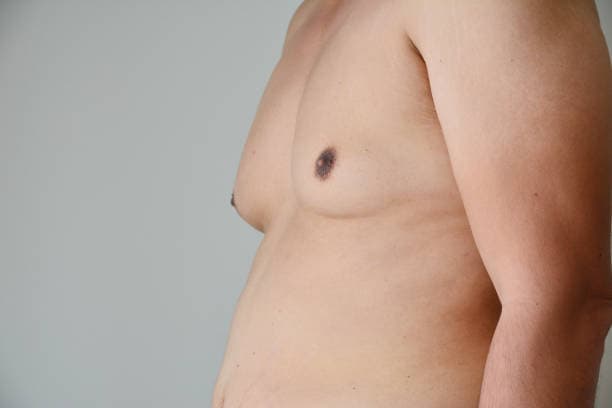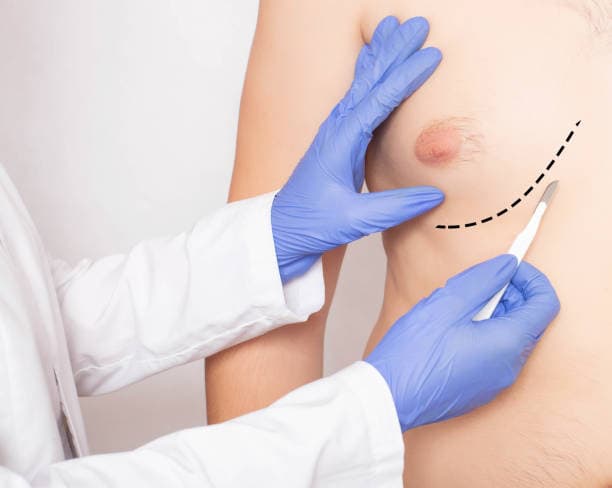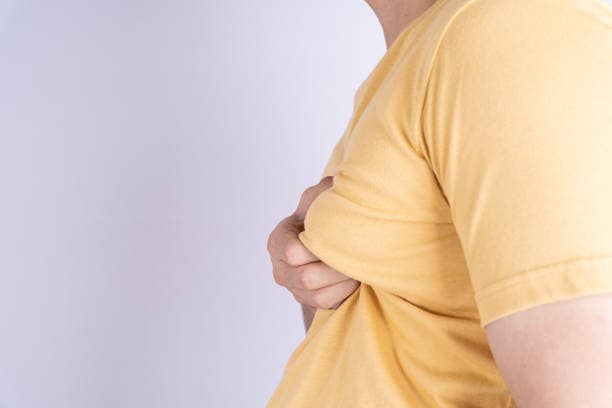Understanding the difference between gynecomastia and chest fat is crucial for determining the appropriate treatment approach. While chest fat can often be reduced through diet and exercise, true gynecomastia usually requires medical or surgical intervention to remove the excess glandular tissue.
Gynecomastia vs. Chest Fat
Gynecomastia and chest fat are two conditions that can result in the appearance of enlarged male breasts, but they have distinct underlying causes. Gynecomastia is characterized by the abnormal development of glandular breast tissue in males, often triggered by hormonal imbalances, certain medications, or underlying health conditions. Chest fat, or pseudogynecomastia, on the other hand, is simply the accumulation of fat in the chest area, usually due to weight gain or obesity.
What is Gynecomastia?
Gynecomastia is a medical condition characterized by the enlargement of breast tissue in males, resulting in a more feminine appearance of the chest. This condition is primarily caused by an imbalance between the hormones estrogen and testosterone. While both men and women produce these hormones, testosterone is typically present at higher levels in men, which helps to inhibit the growth of breast tissue. When this balance is disrupted, either due to increased estrogen levels or decreased testosterone levels, gynecomastia can develop. This hormonal imbalance can be triggered by various factors, including certain medications, medical conditions, lifestyle choices, and natural hormonal changes that occur during different life stages.
Medications known to potentially cause gynecomastia include certain antidepressants, anti-anxiety drugs, antibiotics, heart medications, and treatments for prostate cancer, among others. Additionally, substances like anabolic steroids, alcohol, and marijuana can also contribute to the development of this condition. Medical conditions that affect hormone levels, such as hyperthyroidism, kidney failure, liver disease, and tumors in the testes or adrenal glands, are also potential causes of gynecomastia.
Gynecomastia is commonly seen in newborns, adolescents, and older men, each of these groups experiencing natural hormonal shifts. In newborns, the condition is usually temporary, caused by the transfer of maternal hormones and typically resolves on its own within a few weeks. During puberty, hormonal fluctuations can lead to transient gynecomastia in adolescent boys, which often resolves without treatment within six months to two years. In older men, declining testosterone levels and increased body fat, which can raise estrogen levels, can lead to the development of gynecomastia.
The condition can be identified by the presence of firm, rubbery tissue directly beneath the nipple, which can be tender or painful in some cases. Unlike chest fat, which is soft and diffused, the glandular tissue of gynecomastia is more localized and denser. This distinction is crucial for diagnosis and treatment.
Treating gynecomastia involves addressing the underlying cause when possible. For some, this might mean discontinuing the use of a medication that triggers the condition or treating a related medical issue. In cases where gynecomastia persists or causes significant discomfort or psychological distress, surgical options such as liposuction or mastectomy (removal of the glandular tissue) may be considered to achieve a more traditionally masculine chest contour.

What Causes Gynecomastia?
One of the common causes of gynecomastia is the use of certain medications. These can include drugs used to treat prostate cancer, heart conditions, antidepressants, anti-anxiety medications, antibiotics, and anabolic steroids. Substances like alcohol, marijuana, and opioids can also disrupt hormone levels, leading to the development of gynecomastia.
Medical conditions that affect hormone levels are another significant cause of gynecomastia. These can include hyperthyroidism, which involves the overproduction of thyroid hormones, leading to increased estrogen levels.
Other conditions such as kidney failure, liver disease, and tumors in the testes or adrenal glands can also result in hormonal imbalances that promote the growth of male breast tissue. Additionally, obesity can lead to increased estrogen levels due to the conversion of androgens into estrogens in adipose (fat) tissue.
Natural hormonal changes during different life stages can also contribute to gynecomastia. For instance, newborns can develop gynecomastia due to the transfer of maternal hormones, but this usually resolves on its own within a few weeks. During puberty, hormonal fluctuations are common, and adolescent boys may experience temporary gynecomastia, which often resolves without treatment within six months to two years. In older men, declining testosterone levels and increased body fat, which can elevate estrogen levels, can lead to the development of gynecomastia.
In some cases, gynecomastia can be idiopathic, meaning that no specific cause can be identified. This form of gynecomastia may be related to individual variations in hormone sensitivity or metabolism.

Treatment For Gynecomastia
Treating gynecomastia involves addressing the underlying cause, alleviating symptoms, and, in some cases, improving the appearance of the chest through medical or surgical interventions.
The first step in treatment is often a thorough medical evaluation to identify any potential causes, such as hormonal imbalances, medications, or underlying health conditions. If an underlying cause is found, managing or discontinuing the causative factor may help reduce breast tissue enlargement. For instance, switching medications, treating hyperthyroidism, or addressing liver or kidney conditions can often resolve gynecomastia.
In cases where lifestyle factors like obesity or substance use (e.g., alcohol or steroids) contribute to gynecomastia, lifestyle modifications are recommended. Weight loss through diet and exercise can help reduce the amount of fatty tissue in the chest, potentially alleviating pseudogynecomastia (chest fat) rather than true gynecomastia, which involves glandular tissue growth.
When gynecomastia persists despite these interventions or when it causes significant physical discomfort or emotional distress, medical treatments may be considered. Hormone therapy can be an option, particularly for men with hormone imbalances. Medications like selective estrogen receptor modulators (SERMs) such as tamoxifen or aromatase inhibitors like anastrozole can help reduce breast tissue growth by blocking estrogen's effects or reducing its production. These treatments are usually considered when gynecomastia is painful or does not resolve on its own.
Surgical options are available for those seeking more definitive correction or when medical treatments are ineffective. Two main types of surgery are used to treat gynecomastia: liposuction and mastectomy. Liposuction involves the removal of excess fatty tissue in the chest area and can be particularly effective for cases of pseudogynecomastia. Mastectomy, on the other hand, focuses on removing the glandular breast tissue and is typically performed through small incisions around the nipple. The combined approach of liposuction and mastectomy can be used to achieve the best results, particularly in cases where both fatty and glandular tissues are present.

What is Chest Fat?
Chest fat, also referred to as pseudogynecomastia, is the accumulation of adipose tissue in the chest area of males, giving the appearance of enlarged breasts. Unlike gynecomastia, which involves the development of glandular breast tissue due to hormonal imbalances, chest fat is solely composed of fatty deposits. This condition is primarily associated with overall body fat levels and can occur due to various factors, including poor diet, lack of exercise, and genetic predisposition.
Chest fat is generally soft and diffused, lacking the firm, rubbery texture characteristic of glandular tissue found in gynecomastia. This distinction is important for diagnosing and addressing the condition effectively. While chest fat itself is not typically associated with pain or tenderness, it can cause significant emotional and psychological distress. Men with excess chest fat often feel self-conscious about their appearance, which can impact their confidence and self-esteem.
One of the primary ways to reduce chest fat is through lifestyle modifications. A combination of regular cardiovascular exercise, strength training, and a balanced diet can help decrease overall body fat, including fat in the chest area. Cardiovascular exercises, such as running, swimming, or cycling, are effective for burning calories and reducing fat. Strength training exercises, such as bench presses and push-ups, can help build muscle in the chest, leading to a more toned and defined appearance. Additionally, adopting a diet rich in whole foods, lean proteins, fruits, and vegetables, while limiting the intake of sugary and fatty foods, is crucial for weight management and fat loss.
In some cases, if lifestyle changes are not sufficient to address significant chest fat, individuals may consider cosmetic procedures such as liposuction. Liposuction is a surgical method that removes excess fat from specific areas of the body, including the chest. This procedure can provide more immediate and noticeable results, although it involves certain risks and requires a recovery period.

What Causes Chest Fat?
When an individual consumes more calories than they burn, the excess calories are stored as fat in various parts of the body, including the chest. This imbalance is often influenced by several factors, including poor dietary choices, lack of physical activity, and genetic predisposition.
Diet plays a significant role in the development of chest fat. Consuming high amounts of sugary and fatty foods, processed meals, and beverages loaded with empty calories can lead to weight gain and fat accumulation. These poor dietary habits often result in an increased body fat percentage, which can manifest as excess fat in the chest area.
Additionally, frequent consumption of alcohol can contribute to the accumulation of chest fat, as it contains high-calorie content and can disrupt hormonal balance, further promoting fat storage.
A sedentary lifestyle, characterized by minimal physical activity, is another major contributor to chest fat. Engaging in regular exercise, particularly cardiovascular activities, helps to burn calories and reduce overall body fat. Strength training exercises targeting the chest muscles can also play a crucial role in toning and reducing chest fat. Without these activities, the chest area is more likely to retain fat deposits.
Genetics also play a role in the distribution of body fat. Some individuals are genetically predisposed to store more fat in their chest area due to their body type and hormonal makeup. Hormones, especially estrogen and testosterone, can influence fat distribution. Men with higher levels of estrogen may be more prone to developing chest fat, as estrogen promotes fat storage in certain areas of the body.
Age is another factor that can contribute to chest fat. As men age, their metabolism tends to slow down, and testosterone levels may decrease. This hormonal change can lead to an increase in body fat and a tendency to store fat in the chest area. Additionally, older individuals may be less active, further contributing to weight gain and chest fat accumulation.
In some cases, underlying medical conditions such as hormonal imbalances, thyroid disorders, or certain medications can also contribute to the development of chest fat. Conditions that affect the endocrine system can disrupt the normal balance of hormones, leading to increased fat storage.

Treatment For Chest Fat
The primary approach to managing chest fat is through lifestyle modifications that focus on reducing overall body fat. A balanced diet and regular exercise regimen are crucial components of this strategy. Adopting a diet rich in whole foods, lean proteins, vegetables, and whole grains while reducing the intake of sugary, fatty, and processed foods can help decrease body fat percentage, including fat in the chest area.
Incorporating regular cardiovascular exercises, such as running, swimming, cycling, or brisk walking, helps burn calories and reduce overall body fat. Strength training exercises, particularly those targeting the chest muscles, can also be effective. Exercises like push-ups, bench presses, and dumbbell flyes help build and tone the chest muscles, giving the chest a more defined appearance. Combining cardiovascular workouts with strength training can optimize fat loss and muscle development, contributing to a firmer, more sculpted chest.
For those who find that lifestyle changes alone are insufficient, non-surgical treatments such as body contouring techniques may be considered. Procedures like cryolipolysis (commonly known as CoolSculpting) can effectively target and reduce localized fat deposits. This non-invasive treatment uses controlled cooling to freeze and destroy fat cells, which are then naturally eliminated by the body over time. It is a popular choice for reducing stubborn fat in areas like the chest, where diet and exercise may not achieve the desired results.
In cases where chest fat is more pronounced or persistent, surgical options may be explored. Liposuction is a common surgical method for removing excess fat from specific areas of the body, including the chest. This procedure involves making small incisions and using a cannula to suction out the fat deposits. Liposuction can provide immediate and noticeable results, particularly for those who have not achieved their goals through non-surgical methods.

Conclusion
In conclusion, while both gynecomastia and chest fat result in the appearance of enlarged male breasts, they differ significantly in their causes and treatment approaches. Gynecomastia involves the abnormal growth of glandular breast tissue due to hormonal imbalances and often requires medical or surgical intervention to correct. On the other hand, chest fat is the accumulation of adipose tissue in the chest area, typically due to excess body fat, and can usually be managed with lifestyle modifications such as diet and exercise. Understanding these differences is essential for determining the most effective treatment and achieving the desired chest appearance.
Read More